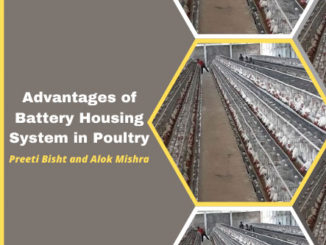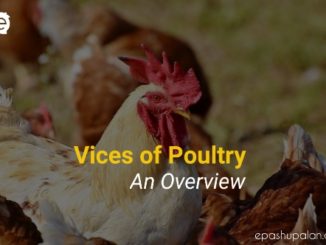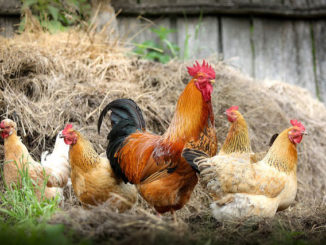Introduction
Keeping the birds are very easy but there are some important Bacterial diseases which causes huge losses in poultry industry and marginal poultry farmers, so knowledge of poultry diseases are very important.

1. Colibacillosis
Cause
Bacterial infection with avian pathogenic Escherichia coli (APEC). coli bacteria are ubiquitous and various serotypes of E.coli are normal intestinal inhabitants. It is estimated that 10-15% of the intestinal coliforms are potentially pathogenic. Infection can be primary or secondary after primary host defense damage (eg respiratory viral infections, Mycoplasma infections, parasites, wounds, nutrition).
Transmission
E.coli are normal intestinal inhabitants and are shed via direct or indirect contact and feces. Egg transmission (via egg surface contamination) is also common and can lead to high chick mortality, environmental presence and vectors like house flies and darkling beetles can also spread E.coli.
Species
Chickens and turkeys, most avian species are susceptible.
Clinical signs and lesions
Clinical signs vary depending on specific disease induced by E.coli. From very mild cellulitis to severe disease; lameness, retarded growth, increased mortality, reduced feed and water intake.
Lesions: colisepticaemia in combinations with polyserositis, salpingitis, osteomyelitis/synovitis, enteritis, meningitis and young birds with omphalitis. Both morbidity and mortality are very variable.
Diagnosis
Clinical signs in combination with isolation and identification.
Treatment
Based on antibiotic sensitivity test.
Control
Hygiene management, hatching egg management and E.coli. vaccination and vaccination against primary causes like respiratory viruses, coccidiosis, IBD, CAV.
2. Fowl Cholera
Cause
Fowl cholera is caused by a bacterium: Pasteurella multocida (several
serotypes).
Transmission
Transmission of fowl cholera is mainly from bird to bird by water or feed contamination. There is no evidence for egg transmission. Vectors like flies and red mite can be carriers and can add to the spread. Rodents (rats and mice) also appear to play a role in contamination of water and feed with Pasteurella multocida.
Species
Turkeys, chickens, ducks and geese, game birds and other bird species are susceptible.
Clinical signs and lesions
Affected birds are depressed and have decreased appetite. Egg production will drop 5-15 % and mortality will be high in acute fowl cholera. Birds that die from acute fowl cholera frequently have bluish combs and wattles. Chronic fowl cholera will not cause high mortality, although there will be an increase in deaths. Swollen wattles is a feature of chronic fowl cholera.
Lesions; acute phase septicaemia, vascular changes in abdominal viscera, hemorrhages, liver swelling with focal necrosis, ovaries appear flaccid and hemorrhagic and show ruptured yolks, Chronic phase; localized infections in conjunctiva, fecial edema, middle ear infection resulting in torticollis, meningeal infection.
Diagnosis
Clinical signs in combination with isolation and identification from samples from birds that died of acute Fowl cholera. (Fresh death birds)
Treatment
Antibiotics based on antibiotic sensitivity test, the earlier the diagnosis the better change of a positive effect of an antibiotic treatment.
Control
Hygiene management and rodent control to eliminate possible sources of Pasteurella multocida. Vaccination can be considered in areas where Pasteurella multocida is prevalent. Both live and inactivated vaccines are available.
3. Infectious Synovitis
Cause
Is a clinical condition caused by different possible agents: Mycoplasma synoviae, Staphylococcus aureus, E.coli and certain reoviruses.
Staphylococcus aureus
Staphylococcus infections are common in poultry and mainly caused by Staphylococcus aureus.
Transmission
Infections generally occur after the breakdown of natural defense mechanisms, due to mechanical damage (eg wounds) or infectious breakdown of the immune system (eg CAV, IBD, Marek’s Disease).
Species
Chickens and turkeys
Clinical signs and lesions
Staphylococcus aureus is ubiquitous and infections can become manifest after breakdown of the natural defense mechanisms such as wounds, inflammation, hematogenous dissemination.
Signs vary with the site of entry, most frequent affected tissues; bone, tendon sheaths and joints. Clinical picture includes lameness in one or both legs, ruffled feathers, swollen joints, fever and increased mortality. Lesions; swollen joints, arthritis, peri-arthritis and synovitis, osteomyelitis, septicaemia-swollen liver-spleen.
Diagnosis
Clinical signs and gross lesions in combination with isolation from affected tissues will confirm Staphylococcus infection.
Treatment
Antibiotic treatment based on sensitivity test. Success is not guaranteed.
Control
Prevent damage to natural host defense mechanisms. Good litter quality, prevent wounds, hatchery management and sanitation. So far vaccination has not been successful.
4. Pullorum disease and Fowl Typhoid
Cause
Pullorum disease is caused by a bacterium, Salmonella pullorum. Fowl typhoid is caused by Salmonella gallinarum, which is related to, but not identical to S. pullorum. Primarily affects chickens and turkeys.
Transmission
Pullorum and typhoid can be transmitted horizontally and vertically by infected (carrier) breeder hens through their eggs. Chickens that hatch from such infected eggs will have typical pullorum disease (white diarrhoea) and high mortality. Infected chickens can also infect other chicks via droppings. Fowl typhoid is more a disease of adult chickens, with high mortality and morbidity. Horizontal transmission is important with fowl typhoid through infected droppings, dead bird carcasses, and infected clothing, shoes, utensils and other fomites.
Species
Chickens and turkeys. Other birds such as quails, pheasants, ducks, peacocks and guinea fowl are susceptible.
Clinical signs and lesions
Birds hatched from S.pullorum or S. gallinarum infected eggs appear moribund or dead in the hatching trays and the young birds will show weakness, depressed appetite, poor growth and increased mortality. In older birds depression. diarrhea, ruffled feathers, pale shrunken combs and drop in egg production and increased mortality will be observed. Morbidity and mortality can be highly variable (mortality can reach 25-60%)
Lesions; acute phase septicaemia-enlarged and congested liver, spleen and kidneys, pericarditis. Hemorrhages. Livers may show white foci. In adult birds atrophic ovarian follicles may be found.
Treatment
Treatment with antibiotics of pullorum/fowl typhoid disease will not cure but reduce clinical signs and is undesirable from a standpoint of eradication. It is far more practical to control the disease by elimination of infected carrier breeder hens. Blood testing (monitoring) of breeder chickens by the serum plate or tube agglutination test with suitable S. pullorum antigen will detect infected carrier birds which can then be culled.
Such control measures will stop the incidence of egg-transmitted pullorum disease/fowl typhoid. If hatching eggs from tested pullorum-free breeders are kept free from contamination through infected eggs from infected breeders or through contaminated equipment, chickens can remain carrier after treatment.
Control
Monitoring and eradication in breeders is the preferred control method. For layers vaccination against fowl typhoid with a special S. gallinarum (9R strain) has been practiced in several countries.
| The content of the articles are accurate and true to the best of the author’s knowledge. It is not meant to substitute for diagnosis, prognosis, treatment, prescription, or formal and individualized advice from a veterinary medical professional. Animals exhibiting signs and symptoms of distress should be seen by a veterinarian immediately. |







Be the first to comment